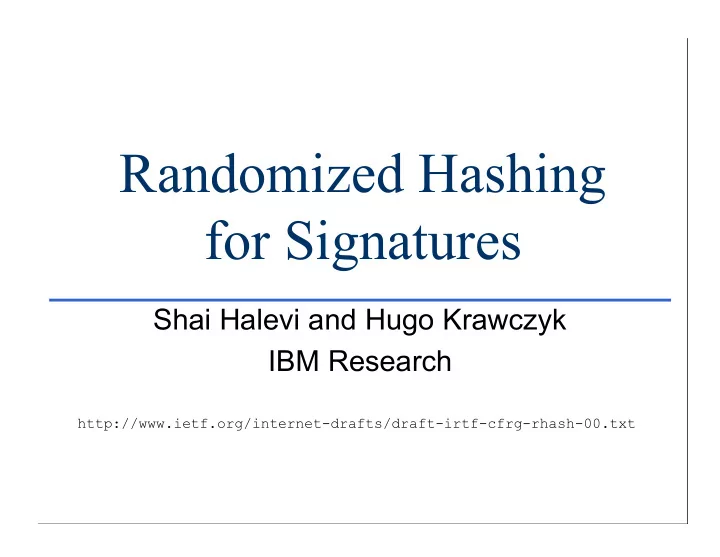

Randomized Hashing for Signatures Shai Halevi and Hugo Krawczyk IBM Research http://www.ietf.org/internet-drafts/draft-irtf-cfrg-rhash-00.txt
Our Proposal: Executive Summary • Hash functions should have a randomized “mode of operation” – This mode needs weaker security properties from the underlying hash function. • Signature standards should use this mode – So that signatures will remain secure even if the hash function in use only has the weaker security.
Note: • This is a general and well-known methodology that's advisable regardless of the specific hash function in use. • This methodology is especially advisable today, when we're not sure about the security of the hash functions we're using.
Hash Functions and Signatures • To sign a message x: – Set h = H(x) – Compute, e.g., s = RSA − 1 ( encode(h) ) – s is the signature on x • If an attacker can find y ≠ x s.t. H(x)=H(y) then s is also a signature on y • ...you were using MD5 for THAT???
How to fix this? • Use more secure hash functions – Do you know of any? • Use schemes that require less security of the underlying hash function – That’s our focus in this I-D – In particular, using randomized/salted hashing
Salted Hashing and Signatures • Use H r (x) instead of H(x) – r is a random “salt value” – Later we’ll talk about how to salt H • To sign a message x: – Choose a new random salt r, set h = H r (x) – Compute, e.g., s = RSA − 1 (encode(h,r)) – The signature is the pair (r,s)
Why is this better? • Finding plain (“off-line”) collisions in H are useless to attacker. • To attack the signatures via finding collisions in H, an attacker needs to: – Obtain signatures (r i ,s i ) on messages x i – For some i, find some y ≠ x i s.t. H r i (x i )=H r i (y). • This seems considerably harder than finding collisions off-line.
S tandard levels of security of hash Functions • Strong: full collision resistance • Weaker: target collision resistance – We’ll mostly focus on this • There are even weaker notions – 2 nd pre-image resistance – One wayness
Full Collision Resistance (CR) • Attacker cannot find any x ≠ y s.t. H(x)=H(y) • That’s a very strong requirement – We should design hash functions to meet this level of security – But also design signature schemes that do not depend on the hash functions meeting such a strong notion of security
Target Collision-Resistance (TCR) • Security against the following attack: – Attacker chooses x – r is chosen at random and given to attacker – Attacker tries to find y ≠ x s.t. H r (x)=H r (y) • Sounds familiar? – Theorem: Using TCR hashing in the mode from four slides ago is sufficient for secure signatures – See [Bellare-Rogaway97,Naor-Yung89]
TCR is weaker than CR • No “birthday paradox”, brute-force attack takes 2 n time rather than 2 n/2 • The attacker needs to interact with the “hasher”, not an off-line attack
Modifying signature standards to use randomized hashing • The main issue is likely to be where to fit the salt component r in existing signature fields – Maybe as part of an AlgorithmIdentifier ? (suggestion due to Burt Kalisky) • In most settings, generating the randomness is unlikely to be an issue
RSA Signatures • It may be possible to use the “message recovery” property of RSA – r can be deduced from encode(h,r) – So the signature is only s = RSA − 1 (encode(h,r)) – To verify you must first compute RSA(s), then recover r and hash • More discussion in the draft
DSA Signatures • DSA signatures already have a format (r,s) with a random r • Hopefully we can use the same r also for hashing • More discussion in the draft
How to Salt a Hash Function? • More Research is Needed on That • Some plausible proposals: – H r (x) = H(r ⊕ x) • if r is shorter than x, just repeat it – Or also interleave r after every block of x – See discussion in the Internet-Draft • Aside: H r (x) = HMAC-H r (x) does not seem to be the right answer
Repeating Executive Summary • Hash functions should have a randomized “mode of operation” – This mode makes weaker security requirements from the hash function in use • Signature standards should use this mode – So that these weaker security requirements will suffice for secure signatures
Two more comments
On “provable security”: • “Provable Security” of signatures is often in the Random-Oracle model • It seems a stretch to use this model when talking about “broken hash functions” • Not clear what model is reasonable for proving security in this context
On “on-line” vs. “off-line” attacks:
On-line vs. Off-line: Scenario #1 Engineer: “We’re using MD5 for certificates, LWW can forge a certificate with about 2 35 off-line computations (takes maybe a few hours on a PC).” Boss: “I want this fixed yesterday, cancel all vacations until it is fixed!” (… and later I’ll fire you for letting this happen) LWW: Lenstra, Wang and Weger
On-line vs. Off-line: Scenario #2 Engineer: “We’re using randomized-MD5 for certificates, LWW can forge a new certificate after we give them about 2 35 valid certificates (2 35 ~ 30 billion).” Boss: “I’m going on vacation now, we’ll discuss this when I’m back.” (… hopefully by then somebody else will fix it)
Is TCR Really the Right Notion? • Actually, an attacker can also: – Request signatures on many messages x 1 …x n – Get (r 1 ,s 1 )…(r n ,s n ) – Tries to find y ≠ x i s.t. H ri (x i )=H ri (y) (for some i) • Note: this is an on-line attack (vs. off-line attacks if the hashing is deterministic)
Recommend
More recommend